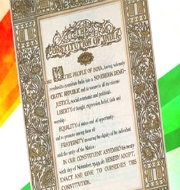First Amendment to the Indian Constitution
The Supreme Court of India agreed to examine the plea challenging the expansion of restrictions to right to freedom of speech and expression that was put in place by the First Amendment to the Indian Constitution. The petitioner challenged that this amendment damages the basic structure doctrine.
About the first amendment to the Indian Constitution
The Bill providing first amendment to the Indian Constitution was introduced by former Prime Minister Jawaharlal Nehru on May 10, 1951 and enacted by the Indian Parliament on June 18, 1951.
The Constitution (First Amendment) Act, 1951 makes several changes to the Fundamental Rights provisions provided by the Indian Constitution. It provides the means to restrict the freedom of speech and expression, validates the prohibition of zamindari system and clarifies that the right of equality does not prevent the government from providing special consideration for weaker sections of the society.
What are the constitutional provisions related to the right to freedom of speech?
Article 19(1)(a) in Part III of the Indian Constitution provides fundamental right to freedom of speech and expression. Clause 2 of the Article lists exemptions to this right, putting place “reasonable restrictions” on the right. The first amendment makes 2 important changes in this clause –
- Introduction of the qualification “reasonable” to the restrictions the Article 19(2) imposes. The term “reasonable” allows the judiciary to examine the legitimacy of the restrictions imposed by the Indian Parliament.
- Introduction of specific terms like “public order” and “incitement to an offence”. These narrower terms were necessitated by the Supreme Court rulings in 1950, which went against the state’s power to curb free speech.
What prompted the first amendment?
The 2 SC cases – the Romesh Thappar case and Brij Bhushan case – prompteed the first amendment.
About Romesh Thappar case
- This case challenged the then Madras Government’s ban on the left-leaning magazine “Cross Roads” after it criticized the government’s foreign policy.
- Majority opinion in the case disagreed with the government’s view that “undermining the security of the State” in Article 19(2) could be equated with “public safety” and “maintenance of public order”.
- Justice Fazal Ali, on the other hand, dissented from the majority view and held that disruption of public order means undermining of the state’s security.
About Brij Bhushan case
During the case, the SC struck down Section 7(1)(c) of the East Punjab Public Safety Act that allowed the government to conduct pre-publication scrutiny of material that is prejudicial to public safety or the maintenance of public order.
Month: Current Affairs – November, 2022
Category: Legal & Constitution Current Affairs


